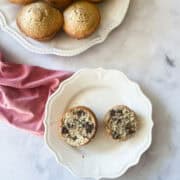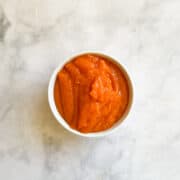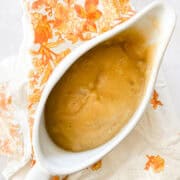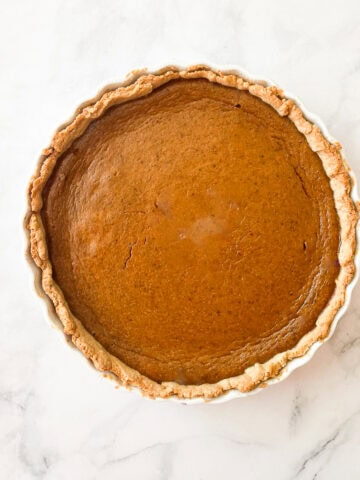A lovely, gluten-free poppyseed cake made from a simple trio of gluten-free flours for the best treat with a cup of coffee.

Gluten-Free Poppyseed Cake
On New Year's Eve I baked a poppyseed cake -- a gluten-free variation of one I made four years ago in Australia (original recipe posted here, it's based on a recipe by Deborah Madison). It's been on my mind to bake this cake again, and I wanted of course to make it gluten-free. It turned out beautifully, with a mix of almond flour, gluten-free oat flour, and sweet white rice flour to create the perfect texture.
This was a proper cake -- fluffy, with a tender crumb, dare I say you'd be hard pressed to identify it as gluten-free. This is the goal, right? Simple ingredients put together to make gluten-free results that taste just as good as any made with all-purpose flour. That was the premise of my cookbook, and one I still hold to today (another reason you won't find any all-purpose gluten-free mixes or recipes calling for gums on my site). I hope you enjoy this one as much as we did.
Why You'll Love This Recipe
- Loaded with poppyseeds. It is a gluten-free poppyseed cake, after all! So I didn't skimp on the poppies.
- You'd hardly guess it's gluten-free! I feel like the best gluten-free cakes are the ones where you casually mention that oh, this is gluten-free after you've received rave reviews. (And is it even necessary to mention it?)
- No added gums. I don't use any gums in my recipes - I don't think you need them if you have the right blend of gluten-free flours. Learn why I don't use gums in my baking.
- Tender crumb. This cake is balanced so well with a mix of oat and almond flours plus sweet white rice flour for texture and structure. More about naturally gluten-free flours.
Gluten-Free Flours Needed
Oat Flour
Oat flour is my absolute favorite gluten-free flour with which to bake. I love it for its light buttery flavor, whole grain nutritional hit, and incredible versatility, especially when used with other gluten-free flours in a recipe.
Almond Flour
Another popular gluten-free flour, almond flour brings structure and keeps gluten-free bakes from being too dry. You can sub for another nut flour if you can't eat almonds; just make sure it's finely ground.
Sweet White Rice Flour
Otherwise known as glutinous rice flour, sweet white rice flour, despite that moniker, is totally gluten-free! It is a great sticky, binding flour that helps keep gluten-free bakes together without the use of gums.

Ingredients in Gluten-Free Poppyseed Cake
- Poppyseeds
- Whole milk
- Oat flour
- Almond flour
- Sweet white rice flour
- Baking powder and baking soda
- Fine sea salt
- Eggs: Use large eggs
- Unsalted butter
- Sugar
- Greek yogurt: I used whole fat plain
- Pure vanilla extract
How to Make Gluten-Free Poppyseed Cake
For the full instructions, see the recipe card at the end of this post.
- Soak poppyseeds. In a small mixing bowl, combine poppy seeds and hot milk. Set aside to soak until needed.
- Combine flours. In a medium-sized mixing bowl, whisk together the flours, baking powder, baking soda and salt.
- Beat egg whites. Beat white until firm peaks form then transfer to a small bowl.
- Cream butter. Cream butter and sugar on medium-high speed until light and fluffy, about 3 minutes. Add the vanilla, then beat in the egg yolks.
- Add poppy seeds. Drain the milk from the poppy seeds. Add seeds to batter along with remaining milk and the yogurt.
- Fold together. Fold the dry ingredients into the wet mixture. Fold in the egg whites.
- Rest better. Let batter rest at least 15 minutes while the oven preheats.
- Bake cake. Bake the cake for 40-50 minutes.
Hint: Cake will be done when the top springs back when lightly pressed and the edges start to come away from the edges of the pan. More gluten-free baking tips.
Substitutions
- Oat flour - try sorghum flour.
- Almond flour - try tiger nut flour or another nut flour.
- Sweet white rice flour - try tapioca flour.
- To make dairy-free - swap coconut oil or your favorite non-dairy butter for the butter. Use coconut milk or your favorite non-dairy milk for the milk. Use your favorite non-dairy yogurt for the yogurt.
Storage
Store cake in the fridge, well covered or in an air-tight container, for 3 days. Serve at room temperature.
FAQ
There are some great health benefits to poppy seeds! They are rich in manganese and high in copper.
It's a good idea. Before you begin a recipe that calls for poppyseeds (or poppy seeds), soak them in hot milk, water or oil from the recipe, or grind them before using. Soaking softens their tough outer coating, so that their unique flavoring compounds is better released by baking temperatures.
They add both! They add a slightly nutty flavor and a lovely crunch to baked goods.

Gluten-Free Poppyseed Cake
Ingredients
- ½ cup poppyseeds
- 1 cup whole milk divided
- ¾ cup/75 g gluten-free oat flour
- ¾ cup/75 g almond flour
- ½ cup/80 g sweet white rice flour
- 1 tablespoon baking powder
- 1 teaspoon baking soda
- ¼ teaspoon fine sea salt
- 3 eggs separated
- ½ cup unsalted butter at room temperature
- 1 cup sugar
- 2 teaspoon pure vanilla extract
- ½ cup Greek yogurt
- ½ cup whole milk
Instructions
- Butter and flour a 9-inch spring form pan. Set aside. Heat ½ cup of milk. In a small mixing bowl, combine the poppy seeds and the hot milk. Set aside until needed.
- In a medium-sized mixing bowl, whisk together the flours, baking powder, baking soda and salt.
- In a large bowl, using an electric mixer, beat the egg whites until firm peaks form. Transfer the egg whites to a small mixing bowl. In another large bowl, beat the butter and sugar on medium-high speed until light and fluffy, about 3 minutes. Add the vanilla, then beat in the egg yolks, adding one at a time and beating well after each addition. Scrape down the sides of the bowl with a rubber spatula as needed.
- Drain the milk from the poppy seeds and discard the milk. In a small bowl, whisk together the whole milk and yogurt, then add to the batter along with the drained poppy seeds. Beat until well combined, then scrape down the sides of the bowl with the rubber spatula. Add the flour mixture to the batter, in thirds, beating well after each addition. Scrape down the bowl, making sure it’s all well mixed. Fold in about a quarter of the beaten egg whites with the spatula, then fold in the rest, mixing gently until just combined.
- Transfer the batter into the prepared cake pan, smoothing the top with the rubber spatula. Let the batter rest for up to 30 minutes. Then preheat the oven to 375ᵒ F.
- Place cake in the oven and bake until golden and firm, with the sides just beginning to pull away from the pan, about 40-50 minutes. Remove from the oven and place on a wire rack. Carefully run a sharp, thin knife along the sides of the cake, just against the pan, then gently remove the rim and allow the cake to cool to room temperature before removing the base of the pan and slicing.
- Cake will keep, well-covered, in the fridge for 3 days.

















I'd love to hear from you! Please leave me a note.